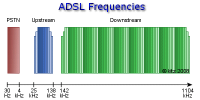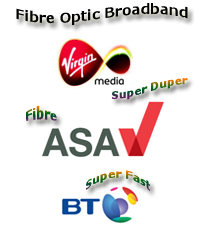Currently in today's market there is some confusion surrounding the term "Fibre Optic Broadband." This page aims to clarify the difference between the various fibre broadband offerings.
~ Types of 'Fibre Optic Broadband'.
Listed below are the main types of Fibre Optic Broadband available.
Hybrid Fibre Coaxial (HFC) Cable Broadband
Available from Virgin Media. Fibre to the cabinet. Uses coax cable from cab to home.
Up to 152Mbps downstream. 12Mbps upstream.
DSL Fibre to the Cabinet (FTTC)
Available from various UK ISPs. BT Openreach Network. Copper phone line from cab to the home.
Up to 80Mbps downstream. 20Mbps upstream.
More Information on FTTC.
Fibre to the Premises (FTTP/FTTH)
True Fibre Network. Available in some regions from BT Openreach plus some localised suppliers such as B4RN, Gigaclear & CityFibre.
BT Openreach: Up to 330Mbps downstream. 30Mbps upstream.
Others: Various - up to 1Gbps downstream. 1Gbps upstream.
More Information on FTTP.
Fibre to the Distribution Point (FTTdp)
Not yet available in the UK and under trial. Brings fibre to the local distribution point with the final few metres over copper wire. BT has in excess of 4.2 million distribution points, these are on top of telegraph poles or in underground joint boxes.
~ What is Broadband?
| Broadband describes a service where data is transmitted over wire cable, with the ability to simultaneously transmit multiple signals over a wide range of frequency channels. |
- The term comes from "broad bandwidth" of frequencies.
- Cable, ADSL and VDSL are all types of broadband.
Technically speaking, Fibre to the Premises is not broadband. FTTP is delivered as a single mode fibre optic cable and doesn't use multiple bands over a broad range of frequencies. |
|
For a more detailed look at how ADSL uses this broad spectrum of sound frequencies see ADSL technology and DMT
|
~ BT Openreach Fibre Network
The diagram below shows a typical BT Openreach local fibre network for FTTC and FTTP.
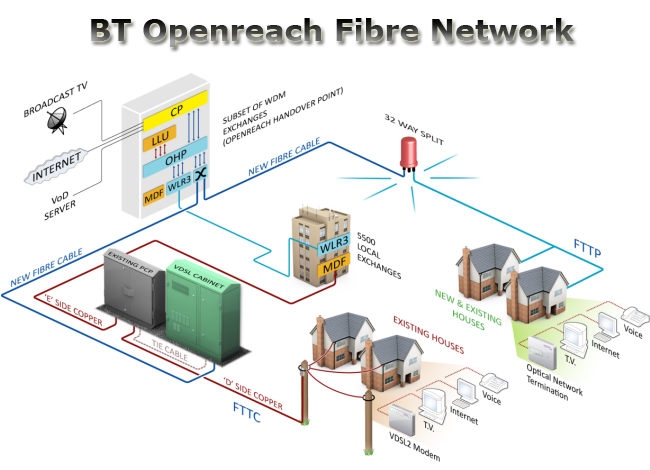
~ Fibre on Demand (FTTPod)
This product is offered by BT Openreach for customers who are on an exchange that is FTTC enabled and who are served by an FTTC enabled cabinet. Customers are not connected via a traditional type of FTTP network, instead BT will run a length of fibre alongside your existing copper run in between the cab to the home.
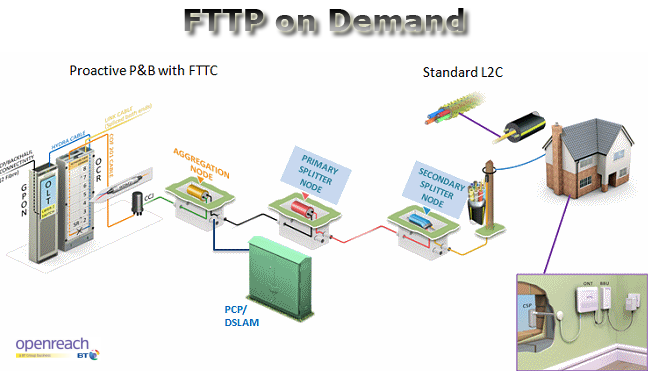
~ Fibre to the Remote Node (FTTrN)
Fibre to the Remote Node (FTTrN) is similar to FTTC where the telco installs a small DSLAM near to several premises. These small nodes can be located on a telephone pole or telco manholes. It is anticipated that BT may use this technology for rural areas or EOL (Exchange Only Lines) where it may be a cheaper option than installing a new FTTC cabinet.

~ The Fibre Optic Broadband Debate - Fibre Optic Broadband which isn't!
Neither Cable broadband nor FTTC are true 'fibre optic broadband'. So how did we get into this silly situation whereby the UK has lots of hype about "fibre", when in other countries fibre means true fibre internet direct to your home?
Virgin Media started the ball rolling in 2007 by advertising their 2Mbps cable service as "super duper Fibre-optic Cable Broadband" trying to distinguish it from, and make it sound superior to 'up to' 8Mbps ADSL broadband.
Virgin Media cable is actually a Hybrid Fibre Coaxial (HFC) network, which means that fibre optic cable is used to carry data only as far as the local cabinet. From the local cab to the home data traverses over coax cable. |
Although many complaints were made to the Advertising Standards Agency, ASA ruled that because coax was used for such a small portion of the network compared to the fibre backhaul, that none of the complaints should be upheld.
This decision surprised many, especially the more technically inclined, because even standard adsl uses just a small portion of copper telephone cable to deliver to the 'last mile' compared to what may be hundreds of miles of fibre optic backhaul. If you want to stretch this slightly further, then the same could be said about dial-up
Therefore it's no surprise that BT et al advertise their Fibre to the Cabinet offerings as "Fibre Optic Broadband" too. ASA has made a rod for its own back, it cant now back down and it effectively opened the floodgates for any SP who provides FTTC to also advertise their product accordingly. |
|
So thanks to ASA not nipping this in the bud, it's why the UK now has the confusing situation of ISPs advertising VDSL FTTC as Fibre Broadband and leaving the consumer no way to differentiate between the true Fibre Product(s) of FTTH/FTTP.
It will be interesting to see what name the telco's marketing departments come up with for FTTdp when it becomes available. ;) |
~ Distribution of speeds by connection technology.
Useful graph that shows distribution of speeds based on the type of technology.
Taken from OFCOM's Infrastructure Report 2014.
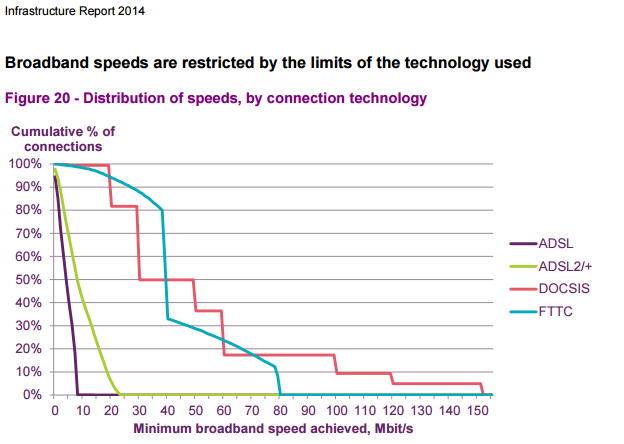
Last updated Oct 2014
Mar 2016 added graph
|



